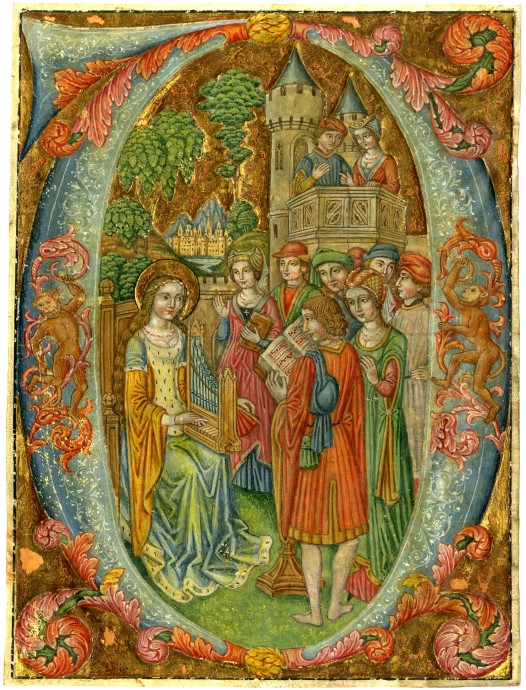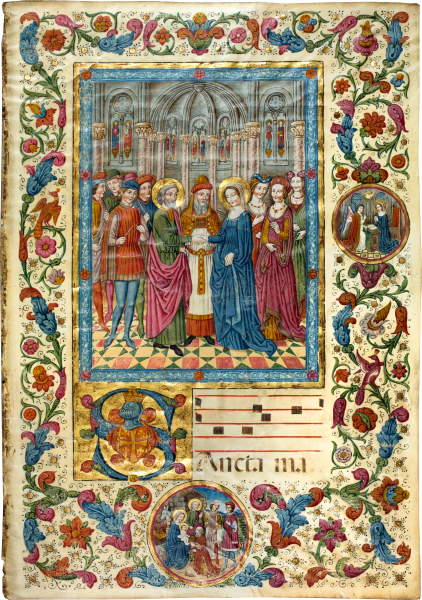


The Spanish Forger
, perhaps after 1925The Spanish Forger
Description
This miniature is typical of a group of historiated initials painted by the Spanish Forger. In a large initial “D,” a seated saint on the left (Cecilia, patron saint of musicians, because she is said to have sung to God even as she was beheaded) plays a portative organ, while a gathering of elegantly attired men and women read, listen, and sing in a lush garden setting beneath a castle. A couple appears on the balcony of the castle. The initial itself is composed of elaborate acanthus and white-dot tracery decoration; cavorting monkeys inhabit the rounded vertical bars of the letter. The Forger loved scenes of music and courtship; they occur frequently in his works (see L22, L23, L96, L97, as well as full-page miniature from an illuminated Gradual, M1.30).
W. Voelkle notes that the Spanish Forger must have responded to the taste of the period for initials cut from manuscripts when he painted these historiated initials. They are marginally larger than the rectangular narrative miniatures perhaps more typical of his oeuvre, but like them they utilize the same parchment stock – a dismembered fifteenth-century Italian Antiphonal. Although it is notoriously difficult to date the miniatures by this artist, Voelkle notes that none of the miniatures from this reused Antiphonal has a provenance that pre-dates 1925.
Unmasked in 1930 by Belle da Costa Green, then director of the Pierpont Morgan Library, the Spanish Forger is known today one of the “most skillful and successful and prolific forgers of all times.” Hundreds of works are attributed to him and in 1978 a retrospective exhibition of his art was organized at the Pierpont Morgan Library in New York. He was active already in the 1890s, and he was still painting in the 1920s. He borrowed freely from chromolithographic editions published in Paris for his compositions, especially the series of publications by Lacroix, which suggests that he may been employed by one of the Parisian publishing houses (remnants of old Parisian newspapers have been found inside the frames). Saint Cecilia in the present miniature closely resemble illustrations taken from Lacroix, Les Arts au moyen age et à l’époque de la renaissance, Paris, 1869 (see Voelkle, pls. 61-63).
Painted on medieval parchment–a reused sheet from an Italian (or perhaps Spanish) Choir Book dated c. 1500–the present miniature demonstrates the Forger’s methods of working. Scientific analyses of his paintings disclose the presence of green copper arsenite, which was not available before 1814. Except for minor flaking of the gold and inconsequential rubbing of the paint, the miniature is in bright, fresh condition.
Literature
The present miniature is unpublished in William Voelkle and Roger S. Wieck, The Spanish Forger, New York, Pierpont Morgan Library, 1978, but it is recorded in the ongoing inventory L100.
